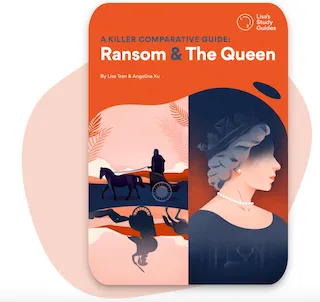Like a House on Fire is usually studied in the Australian curriculum under Area of Study 1 - Text Response. For a detailed guide on Text Response, check out our Ultimate Guide to VCE Text Response.
Contents
- Historical Context
- Themes
- Essay Planning
- Essay Topics
- Resources
1. Historical Context
Kennedy’s anthology of fifteen short stories, Like a House on Fire, explores the impacts of familial and social issues on an individual’s sense of identity and humanity, illustrating the vast spectrum of human condition. Having lived a majority of her life in Victoria, Australia, Kennedy’s collection follows the stories of various protagonists whose voices are characteristic of Australian culture and society. As the text is set in the backdrop of rapid Australian modernisation, the novel also depicts the paradoxical nature of technology, as various characters are depicted to be torn between confronting or embracing this fundamental change. Despite approaching the stories of characters conflicted by modern and social challenges with both humour and cynicism, Kennedy’s lack of judgement is notable; it is with this empathetic stance that she is able to the universal nature of human emotions to her readership.
2. Themes
Identity
Kennedy explores the theme of identity mainly through physical injury, as various characters with physical trauma find themselves to be agonisingly limited within the confines of their condition. In Like a House on Fire, the narrator’s sense of identity becomes intertwined with his subsequently decreased masculinity, as his back injury leaves him unable to physically take care of his family, and his wife begins to undertake stereotypically masculine roles within the household. In tandem with this, Roley’s wife in Little Plastic Shipwreck is rendered humourless and witless due to her brain injury, distorting her once enthusiastic self into one shadowed by her illness; further emphasising the link between physical and mental identity.
Order and Disorder
The inherent tension between order and chaos is continually examined throughout the anthology, particularly in Like a House on Fire, in which perfectionistic order and scatter minded disorder are embodied in the unnamed narrator and his wife respectively. As the two individuals are unable to establish a compromise between their contrasting personalities, Kennedy suggests that this lack of cooperation is the core reason for the deterioration of their marriage, and their subsequent misery. The notion of disorder is also symbolised by the domestic setting itself, as Kennedy depicts various characters who feel pervasive ennui and dissatisfaction within the ‘chaotic mess’ of their household environments.
Longing
Each protagonist in the collection is portrayed as possessing some object of longing, whether it be material or emotional. Kennedy utilises scattered verses of prose within her writing to communicate these human desires, building upon their significance poetically. In Static, Anthony attempts to negotiate his own wishes with those of his wife and family, leading him to wonder whether anything present in his life has been created by his own will or merely his eagerness to please others. His desire for various types of happiness, embodied in material concepts such as money or children, suggest that the human condition is built upon the foundation of dissatisfaction; that innate longing is what ultimately defines us as human.
Love
The theme of love is present in each story of the collection, often used as an instrument through which the characters can heal and grow from their physical or spiritual pain. While suggesting that true love endures all hardship in Like a House on Fire, Kennedy also illustrates the various sacrifices one must make in order to protect the ones you love. Such is depicted in Five-Dollar Family, as a new mother makes the difficult decision of leaving her ‘loser’ boyfriend to give her child a chance at the best life possible, despite the unfortunate situation he has been born into.
Communication
The vital importance of communication within families is emphasised in the anthology, as the lack of effective communication perceivably exacerbates dysfunctional relationships. The crushing regret of a son is explored in Ashes, as he laments his lack of communication with his father who he can no longer speak to. However, Kennedy empathetically depicts the difficulty of communicating potentially painful messages to loved ones in Waiting, as the protagonist anxiously agonises over the prospect of telling her husband that she may have another miscarriage following an excruciating string of lost children.
Empathy
In tandem with longing, Kennedy asserts that empathy is vital to the survival and happiness of a human being. This notion is aptly depicted in Little Plastic Shipwreck, in which the death of Samson the popular show dolphin results in Roley’s revelation of his manager’s complete lack of empathy, and subsequently the abundance of his own. Similarly, the salient importance of empathy is emphasised in Flexion, as the cold-heated and harsh victim of a brutal tractor incident repairs his marriage by allowing himself to feel more empathy for those who have supported his recovery and been understanding of his bitterness.
Family
The anthology centres around the concept of family, as both dramatic events unfold directly due to altercations and misunderstanding within the household. By depicting both the dramatic and mundane events that contribute to creating dysfunctional families, Kennedy asserts that kindness and understanding is vital to the maintenance of a healthy and loving family. The power of family is also depicted in Like a House on Fire, as the protagonist’s dissatisfaction with life is instantly washed away by the actions of his children, who remind him that despite his life-threatening injury, his family is his constant source of love and support.
If you'd like to see how themes like these can be identified and analysed in one of Kennedy's short stories, you might like to check out our Close Analysis Of 'Cake' From Like A House On Fire blog post!
______
By the way, to download a PDF version of this blog for printing or offline use, click here!
______
3. Essay Planning
Whenever you get a new essay topic, you can use LSG’s THINK and EXECUTE strategy, a technique to help you write better VCE essays. If you’re unfamiliar with this strategy, then check it out in How To Write A Killer Text Response.
Question 1: ‘Gender plays no role in the tragic identities of the characters in Like a House on Fire.’ To what extent do you agree?
Suggested contention: Despite the ubiquitous nature of hardship, the short stories of Like a House on Fire explore the effect of gender roles on individuals’ sense of self-worth.
Body paragraph 1:
- Pain is depicted to have no partiality to either gender in Like a House on Fire.
- Much of the trauma explored throughout the anthology is a result of lack of emotional connection or familial misunderstanding arising through individual actions, rather than due to stereotypes associated with gender.
- Kennedy suggests that there is no gender more at fault for these issues, but rather that it is mindset that determines one’s identity and fate, especially in relationships. For example, just as the protagonist’s wife in Flexion makes the mistake of cruelly wielding her physical dominance over her husband, the passive boyfriend in Five-Dollar Family is cruel in his apathy toward his girlfriend and their newborn baby.
Body paragraph 2:
- Despite this, Kennedy explores the social views that plague men as a result of their gender, compelling to limit their identity to meet these fatal expectations.
- The concept of masculinity is explored throughout the collection, often presented as an inferiority complex for many male protagonists due to their physical disabilities. The societal idea that men should be physically strong in order to be able to provide for his family is heavily condemned in Like a House on Fire, as Kennedy depicts the destructive consequences of such on one’s sense of self-worth.
- For example, the narrator of Like a House on Fire perceives his own physical weakness as unmanly, and subsequently himself as an unfit and useless father. As he is unable to pick up the family’s Christmas tree, the tree seller looks towards him with disdainful judgment, perceiving the protagonist’s wife lifting the tree to be ‘destroying the social fabric’.
- In addition to this, the narrator’s extreme attempt to physically help the family results in the destruction of the precious family nativity scene, symbolising the idea that social constructs of masculinity inevitably ends in destruction, as the narrator’s inability to recognise his physical limitations only exacerbates the problem.
Body paragraph 3:
- In tandem with this, the collection of short stories also examines the social limitations placed upon women solely due to their gender.
- The difficulty for women to balance their roles of mother and career woman is explored in Cake, in which the protagonist Liz fails to separate one from the other, leading her to feel dissatisfaction in both. Kennedy ostensibly denounces the social expectations of women to be domestic helpers, as Liz faces judgement at work for bearing a child, whereas her husband is exempt from any judgement despite it also being his son.
- The complicated and personal concept of pregnancy is further depicted in Waiting, as the protagonist agonises over the fact that she may lose another child due to a miscarriage. As the fear of disappointing others takes over her own pain and anguish, readers of the collection are invited to consider the harrowing expectations placed on women to be successful mothers.
Question 2: ‘Like a House on Fire shows that family relationships are never perfect.’ Do you agree?
Suggested contention: Through the constant depiction of dysfunctional families in Like a House on Fire, Kennedy asserts the importance of communication and empathy in repairing broken relationships, and suggests that perfect families are unrealistic.
Body paragraph 1:
- Every story in the collection depicts a family undergoing some kind of hardship, whether it be financial, emotional or spiritual. Through her depiction of broken families, Kennedy suggests that emotional stress and tension within families is sometimes inevitable, even in a loving and supportive environment.
- The title of the collection, Like a House on Fire, is emblematic of the dual nature of families, as while the phrase symbolises the chaos and disorder of one’s family dynamic, it also symbolises the love and extreme passion that often coexists alongside it.
- For example, while the protagonist in Like a House on Fire reminisces upon the ‘fiery’ sexual and emotional happiness of their marriage, he also deplores their current period of domestic stress, describing it as a ‘house on fire’.
Body paragraph 2:
- Kennedy depicts the need for family members to engage in open and honest communication with one another to overcome the effects of trauma.
- For example, in Ashes, Chris is only able to find closure by finally understanding the mindset off his parents through effective communication. His newly found ability to express his true emotions to his mother allows him to finally perceive the grief that was masked by her supposedly ‘cruel’ actions, and subsequently finally achieve a stable relationship with her.
Body paragraph 3:
- Kennedy also advocates for the exercise of empathy between family members in order to find harmony within dysfunction.
- This is apparent in Flexion, in which the seemingly emotionless protagonist and his wife undergo their respective journeys of expressing empathy for the other. As their marriage significantly improves due to their increased understanding of each other, Kennedy promotes the importance of vulnerability and openness within families.
Beyond the Basics:
How does Kennedy’s short story format add to the reader’s understanding of the themes uncovered in the novel?
- The range of diverse, Australian voices depicted in the anthology work to portray the vast spectrum of the human condition.
- The concise narrative present in each of the fifteen stories work to provide the readership with an extremely personal point of view that emphasises the emotions and mindset of the protagonist, furthering the sense of authorial empathy and compassion.
- It is through this almost voyeuristic advantage we subsequently possess as readers, that we are able to fully understand the depth of each character’s humanity and sense of identity, as well as the various struggles that follow the course of an individual’s life.
- Kennedy’s ordering of the short stories also contributes to the reader’s depth of understanding. There is no apparent chronological order present in the collection, but rather a varied order of stories, depicting its diverse range of voices. For example, while the key themes and tones of the anthology remain consistent throughout, other factors such as age, gender and life experience of the protagonist vary in order to provide contrasting character viewpoints.
- As such, this variation in narrative voice allows Kennedy to present her stories as universal human experiences, emphasising the ubiquitous nature of the themes present in Like a House on Fire.
- Finally, the varied structure within each individual story lends an optimistic tone that underscores the entirety of Kennedy’s work. While some stories such as Flexion begin with the inciting event, others emphasise the chain of events that occur in leading up to the key event, as depicted in Ashes. As the undertones of hope and faith are present throughout the collection, the varied plot structure of each story allows Kennedy to assert that no matter the circumstance of hardship, one can always find a glimpse of optimism within its depths.
If you'd like to see another essay topic breakdown, you might like to check out our Like a House on Fire Essay Topic Breakdown blog post!
4. Essay Topics
The following essay topics are extracted from our Like a House on Fire Study Guide:
- In Like a House on Fire, Kennedy illustrates that perfect families do not exist, and that family dysfunction is inevitable. To what extent do you agree?
- The characters in Like a House on Fire are largely defined by social expectations of their gender. Discuss.
- In Like a House on Fire, how does Kennedy show that in even times of hardship, human strength will prevail?
- ‘The range of narrative points of views used in Like a House on Fire illustrate the characters’ deeply personal responses to life’s challenges.’ Discuss.
- ‘…As the lifetime habit of keeping his responses to himself closed his mouth in a firm and well-worn line.’ How does Kennedy present communication as a key issue in the relationships in Like a House on Fire?
If you'd like to see A+ essays on these essay topics, complete with annotations on HOW and WHY the essays achieved A+ so you can emulate this same success, then you'll definitely want to check out our Like a House on Fire Study Guide! In it, we also cover advanced discussions on topics like authorial views and values, symbols and motifs and context completely broken down into easy-to-understand concepts so you can smash your next SAC or exam! Check it out here.
5. Resources
Download a PDF version of this blog for printing or offline use
Like a House on Fire Essay Topic Breakdown
How To Get An A+ On Your Like A House On Fire Essay
Close Analysis Of 'Cake' From Like A House On Fire
The Ultimate Guide to VCE Text Response
How To Write A Killer Text Response Study Guide
How to embed quotes in your essay like a boss
How to turn your Text Response essays from average to A+
5 Tips for a mic drop worthy essay conclusion
The Importance of the Introduction












.jpg)